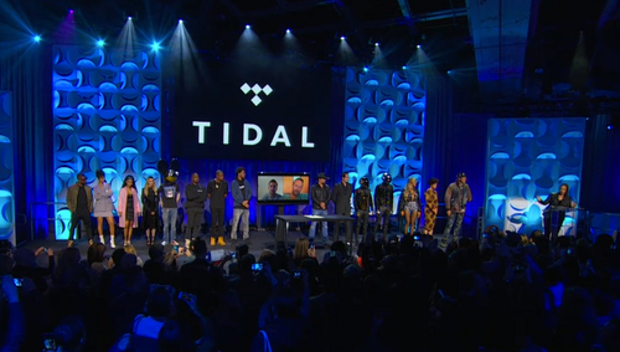 Last March rap mogul Jay Z bought the Swedish music streaming platform Tidal for $56 million. That’s a lot of money to pay for a subscriber base of only 35,000 in 35 markets (Ireland among them). Still, its modest scale didn’t get in the way of a massive relaunch event held on Monday announcing a new dawn in music, backed up by a panel of performing artists from Kanye West to Madonna to Coldplay’s Chris Martin. It even came with the signing of a ‘declaration’ meaning… something.
Last March rap mogul Jay Z bought the Swedish music streaming platform Tidal for $56 million. That’s a lot of money to pay for a subscriber base of only 35,000 in 35 markets (Ireland among them). Still, its modest scale didn’t get in the way of a massive relaunch event held on Monday announcing a new dawn in music, backed up by a panel of performing artists from Kanye West to Madonna to Coldplay’s Chris Martin. It even came with the signing of a ‘declaration’ meaning… something.
Tidal’s appeal lies in an impressive catalogue of 25 million songs available in a high-definition lossless format. If you want CD-quality sound with the convenience of Spotify then Tidal is one solution to your ills. That’s assuming you can afford $19.99 a month to sink into it.
With services like YouTube, Spotify and Deezer using freemium models where price points operate on a sliding scale, it’s hard to see how Tidal’s one-size-fits-all approach can change the music streaming space. Jay Z’s pitch is based on star power, quality and the moral imperative of paying a fair price for the music you enjoy. The goal is laudable and Jay Z is as savvy a businessman as he is a lyricist but its his eye for an opportunity that could end up rendering Tidal a luxury alternative on the fringes of the market. Lets take the pillars of his strategy in turn.
It’s full of stars
Tidal’s relaunch centred on the appearance of a panel of luminaries straddling musical genres. After short keynotes delivered by Tidal executive Vania Schlogel and former Blackberry creative director Alicia Keys, the signatories of Tidal’s manifesto showed up, stood about, signed the document, stood some more then left the stage. Whooping from the audience included, the announcement took less than 20 minutes and mentioned no details about plans for expansion, or new features beyond vague promises of video and exclusive editorial content.
A stirring call-to-arms for artists? More like popular music’s one-percent announcing open auditions for friends. “Because Madonna said so” isn’t much of a reason to spend money. Even less so: “Because Chris Martin thinks it’s a great idea”.
Price
Streaming services know all about the trade-off between quality and convenience. Better quality means more demands on networks. If your 3G mobile connection has a monthly data cap of 2Gb you might find yourself regularly going over your monthly allowance. That $19.99 a month quickly becomes $19.99+ extra data at a time when the cost of CDs is declining. Unless you buy more than one CD a month you won’t be saving money on your monthly entertainment budget.
As the success of Netflix has shown, when it comes to online sometimes good enough is just that. For the same reason you do not need high-end headphones on your morning commute, you do not need high-end audio. At home, the case for a better audio experience is more compelling but with Spotify already boasting over 60 million active users and 15 million subscribers paying $9.99 a month, that’s a lot of ground to make up.
Tidal may not want to conquer the world, though. Neil Young’s crowdfunded Pono music player is a modestly successful iPod competitor designed for lossless audio and has a substantial music store where soft copies are often pricier than CDs. Reassuringly expensive? Definitely. Mass market? Definitely not. And that’s ok.
The moral imperative
There’s not much of an argument here. Creators deserve to be paid a fair price for their labour. The actual effect of piracy on sales may never be known but what we do know is that record labels failed to negotiate properly with Apple when setting iTunes’ per-track prices and passed along the impact of that blunder to artists. The advent of streaming has given labels a whole new way to mishandle artist royalties to the extent that one digital sale (already a bad deal) is worth as much as 33 Spotify streams. It might seem a wretched deal but subscriptions at least keep users within a walled garden and within the ‘revenue loop’ so at least they are contributing to artist upkeep.
The problem is that many pirates have a ready-made counter argument to this: a) that a massively wealthy industry screwed over its own artists; b) said industry’s output is overpriced and declining in quality; and c) artists make most of their money off live appearances and endorsements.
The above is largely true but doesn’t take away from the fact that the pirate made a value decision not to support the artist.
An artist-run alternative streaming service would cut outan element of tech speak and provid the sense of a direct line from fan to artist but whether that’s enough to make a serial pirate change their ways is debateable. Actually, it’s not. An expensive service will not change a freenik into a full functioning and commercially valuable member of the digital economy.
Tidal isn’t the saviour of music but neither is it a vanity project. No one in music has enough star power to get people to pay twice the going rate for a service that isn’t as good as its main competitor. True audiophiles may see things differently and be attracted to a quality alternative – assuming they can be dragged away from their Pono players to give it a try.








Subscribers 0
Fans 0
Followers 0
Followers